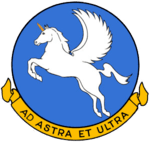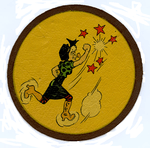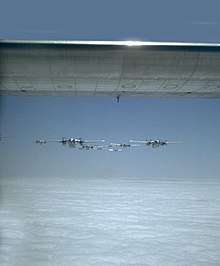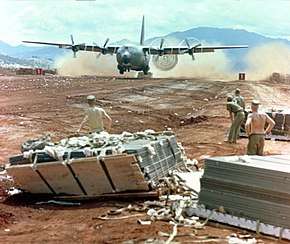817th Expeditionary Airlift Squadron
| 817th Expeditionary Airlift Squadron | |
|---|---|
 Members of the 8th Airlift Squadron are welcomed home as they return from deployment to Southwest Asia[note 1] | |
| Active | 1943–1945; 1953–1970; 2002–2014 |
| Country | United States |
| Branch |
|
| Role | Airlift |
| Motto(s) | Ad Astra et Ultra Latin To the Stars and Beyond[1][note 2] |
| Engagements |
Mediterranean Theater of Operations Korean War Vietnam War |
| Decorations |
Distinguished Unit Citation (2x) Air Force Outstanding Unit Award s/> |
| Insignia | |
| 817th Expeditionary Airlift Squadron emblem (approved 19 August 1958)[2] |
 |
| Unofficial 817th Troop Carrier Squadron emblem (Korean War era) |
 |
| Unofficial 817th Bombardment Squadron emblem[3] |
 |
The 817th Expeditionary Airlift Squadron is a provisional United States Air Force unit. It was engaged in combat operations in Southwest Asia. It was inactivated in 2014, however it can be reactivated by Air Mobility Command at any time needed for contingency operations.
During World War II as the 817th Bombardment Squadron, it was one of the last Boeing B-17 Flying Fortress heavy bomber squadrons deployed to southern Italy as part of the Fifteenth Air Force 483d Bombardment Group in March 1944.
The squadron was converted to airlift operations and activated in the Pacific area, where it served during both the Korean and Vietnam Wars until it was inactivated in 1970.
Mission
The squadron was equipped with McDonnell Douglas C-17 Globemaster III transports and supported Coalition forces engaging in combat operations as part of Operation Enduring Freedom and Operation Iraqi Freedom, and also operated in the Horn of Africa.
The mission of the 817th was to provide global strategic airlift, airdrop, aeromedical evacuation and humanitarian relief, to create an air bridge for personnel, equipment and supplies throughout their assigned areas of responsibility.
History
World War II

The squadron was activated at Ephrata Army Air Base as the 817th Bombardment Squadron (Heavy) on 20 September 1943 as one of the four original squadrons of the 483d Bombardment Group. In November, the squadron moved to MacDill Field, Florida, where it trained with Boeing B-17 Flying Fortresses under Third Air Force.[2][4]
The 817th deployed to the Mediterranean Theater of Operations, where it became part of Fifteenth Air Force at Sterparone Airfield in Southern Italy.[2] The squadron's air element flew its Flying Fortresses to Sterparone via Tortorella Airfield, while the ground element moved to Sterparone via troop ship.[5] It began operations in April 1944 with an attack on a cement factory in Split, Yugoslavia.[6]
The squadron engaged in long-range strategic bombardment of enemy military, industrial and transport targets, including factories, oil refineries, marshalling yards, airfields, and troop concentrations in Italy, France. Southern Germany, Austria, Czechoslovakia, and the Balkans.[4] In June 1944, the squadron participated in a shuttle mission, departing Italy and landing in the Soviet Union, attacking targets en route and on the return flight. This enabled attacks on targets too far from the squadron's base to strike and return home.[7] The squadron received a Distinguished Unit Citation for combat action two months later. On 18 July 1944 the squadron, along with the other elements of the 483d Group, bombed the objective, an airfield and installations at Memmingen, engaging numerous enemy aircraft in the target area despite a lack of cover from its planned fighter escort. It received a second citation for braving fighter assaults and flak to bomb tank factories at Berlin on 24 March 1945.[4]
The squadron was occasionally diverted from the strategic attack on Germany. It struck targets in southern France in preparation for Operation Dragoon, the invasion of August 1944. The group also supported ground forces in northern Italy during the Allied offensive in April 1945.[4]
After V-E Day, the unit moved to Pisa Airfield,[2] where it operated under the control of Air Transport Command's Green Project which was the movement of troops back to the United States. The squadron carried troops from Pisa to a staging area in Morocco. Its B-17s were disarmed with flooring and seats for 25 passengers installed. It carried passengers from Pisa to Port Lyautey Airfield, French Morocco for further movement them across the Atlantic. The squadron was inactivated in Italy in September 1945.[2]
Korean War

The Air Force was returning the 403d Troop Carrier Wing, which was stationed at Ashiya Air Base during the Korean War to reserve status at the beginning of 1953. The 403d Wing had been mobilized in April 1951 and had moved to Japan a year later.[8] In its place, the Air Force activated the 483d Troop Carrier Wing.[9] The 817th was activated as the 817th Troop Carrier Squadron and absorbed the mission, personnel and Fairchild C-119 Flying Boxcars of the 65th Troop Carrier Squadron, which was simultaneously inactivated.[2][10]
In June 1953, the squadron, along with the other squadrons of the 483d Wing airlifted the 187th Regimental Combat Team from Japan to Korea, to prevent a breakthrough by North Korean and Chinese Communist forces before an armistice agreement could be signed.[9] It performed troop carrier and air transport operations in the Far East, including landing of troops and cargo in forward areas of the combat zone, air transportation of airborne troops and equipment, and air evacuation of casualties,[4] receiving a Korean Presidential Unit Citation for these actions.[2] For its actions in transporting United Nations troops in Korea and training with airborne units, the squadron was one of the first units to earn an Air Force Outstanding Unit Award. Between April 1953 and September 1954, the squadron aided the French Air Force in Indochina by training personnel and hauling supplies.[4] In 1958, the 483d Group was inactivated as Far East Air Forces converted to the dual-deputy organizational model and the squadron was reassigned directly to the wing. That same year, the squadron began conversion to the Lockheed C-130A Hercules, losing its last Flying Boxcar in 1959.[2]
Vietnam War

On 25 June 1960, the Air Force turned Ashiya Air Base over to the Japanese Air Self Defense Force and the 483d Wing was inactivated. The squadron moved to Naha Air Base, Okinawa, where it was assigned directly to the 315th Air Division.[2] It continued intratheater transport operations, also flying to locations in the Philippines, Thailand and Indochina, supporting United States civilian and military personnel assigned to the region. As the United States increased its combat presence in Indochina in the early 1960s, made frequent flights to airfields in South Vietnam and to locations within the country, periodically deploying crews and aircraft there. As in South Korea, the flights within South Vietnam were extremely hazardous as the squadron operated within combat areas and frequently were under fire from communist forces during takeoff, landing and ground operations. The squadron inactivated in June 1970.[2]
Expeditionary operations
Reactivated in 2002 as a Boeing C-17 Globemaster III squadron as part of the Global War on Terrorism. Provided intra-theater transport within Southwest Asia and other locations as directed in support of units engaged in combat operations.
Lineage
- Constituted as the 817th Bombardment Squadron (Heavy) on 14 September 1943
- Activated on 20 September 1943
- Re-designated 817th Bombardment Squadron, Heavy c. September 1944
- Inactivated on 25 September 1945
- Re-designated 817th Troop Carrier Squadron, Medium on 15 November 1952
- Activated on 1 January 1953
- Redesignated 817th Troop Carrier Squadron on 8 December 1965
- Redesignated 817th Tactical Airlift Squadron on 1 August 1967
- Inactivated on 15 June 1970
- Redesignated 817th Expeditionary Airlift Squadron and converted to provisional status, on 12 June 2002[2]
- Activated c. 2002
- Inactivated on 1 April 2014
Assignments
- 483d Bombardment Group, 20 September 1943 – 25 September 1945
- 483d Troop Carrier Group, 1 January 1953
- [[483d Troop Carrier Wing, 8 December 1958 * 315th Air Division]], 25 June 1960[11] (attached to 6315th Operations Group)
- 374th Troop Carrier Wing (later 374th Tactical Airlift Wing), 8 August 1966 – 15 June 1970
- Air Mobility Command to activate or inactivate at any time after 12 June 2002[2]
Stations
- Ephrata Army Air Base, Washington, 20 September 1943
- MacDill Field, Florida, 7 November 1943 – 2 March 1944
- Sterparone Airfield, Italy, 9 April 1944
- Pisa Airfield, Italy, 15 May 1945 – 25 September 1945
- Ashiya Air Base, Japan, 1 January 1953
- Naha Air Base, Okinawa, 25 June 1960 – 15 June 1970[2]
- Southwest Asia, 2002–2014
Aircraft
- Boeing B-17 Flying Fortress, 1943–1945
- Fairchild C-119 Flying Boxcar, 1953–1959
- Lockheed C-130 Hercules, 1958–1970[2]
- Boeing C-17 Globemaster III, 2002–2014
Awards and campaigns
| Award streamer | Award | Dates | Notes |
|---|---|---|---|
| Distinguished Unit Citation | 18 July 1944 | Germany, 817th Bombardment Squadron[2] | |
| Distinguished Unit Citation | 24 March 1945 | Germany, 817th Bombardment Squadron[2] | |
| Presidential Unit Citation | 8 August 1967-7 August 1968 | Vietnam, 817th Troop Carrier Squadron (later 817th Tactical Airlift Squadron)[2] | |
| Air Force Outstanding Unit Award with Combat "V" Device | 1 September 1968-15 June 1970 | 817th Tactical Airlift Squadron[2] | |
| Air Force Meritorious Unit Award | 1 June 2010-31 May 2011 | 817th Expeditionary Airlift Squadron[12] | |
| Air Force Outstanding Unit Award | 6 May 1953-10 September 1954 | 817th Troop Carrier Squadron[2] | |
| Air Force Outstanding Unit Award | 1 January-30 June 1961 | 817th Troop Carrier Squadron[2] | |
| Air Force Outstanding Unit Award | 1 July 1964-30 April 1966 | 817th Troop Carrier Squadron[2] | |
| Air Force Outstanding Unit Award | 8 August 1966-7 August 1967 | 817th Troop Carrier Squadron[2] | |
| Air Force Outstanding Unit Award | 1 October 2006-30 September 2007 | 817th Expeditionary Airlift Squadron[12] | |
| Air Force Outstanding Unit Award | 1 October 2007-30 September 2008 | 817th Expeditionary Airlift Squadron[12] | |
| Air Force Outstanding Unit Award | 1 October 2008-30 September 2009 | 817th Expeditionary Airlift Squadron[12] | |
| Republic of Korea Presidential Unit Citation | 1 January 1953-28 July 1953 | 817th Troop Carrier Squadron[2] | |
| Republic of Vietnam Gallantry Cross with Palm | 1 September 1969-15 June 1970 | 817th Tactical Airlift Squadron[2] |
| Campaign Streamer | Campaign | Dates | Notes |
|---|---|---|---|
| Air Offensive, Europe | 9 April 1944–5 June 1944 | 817th Bombardment Squadron[2] | |
| Normandy | 6 June 1944–24 July 1944 | 817th Bombardment Squadron[2] | |
| Northern France | 25 July 1944–14 September 1944 | 817th Bombardment Squadron[2] | |
| Rome-Arno | 22 January 1944–9 September 1944 | 817th Bombardment Squadron[2] | |
| Southern France | 15 August 1944–14 September 1944 | 817th Bombardment Squadron[2] | |
| North Apennines | 10 September 1944–4 April 1945 | 817th Bombardment Squadron[2] | |
| Po Valley | 3 April 1945–8 May 1945 | 817th Bombardment Squadron[2] | |
| Rhineland | 15 September 1944–21 March 1945 | 817th Bombardment Squadron[2] | |
| Central Europe | 9 April 1944–21 May 1945 | 817th Bombardment Squadron[2] | |
| Air Combat, EAME Theater | 9 April 1944–11 May 1945 | 817th Bombardment Squadron[2] | |
| Third Korean Winter | 1 January 1953-30 April 1953 | 817th Troop Carrier Squadron[2] | |
| Korea Summer-Fall 1953 | 1 May 1953-27 July 1953 | 817th Troop Carrier Squadron[2] |
See also
References
- Notes
- ↑ Taken 5 April 2013 at Joint Base Lewis-McChord, Washington. The airmen were deployed to the 817th Expeditionary Airlift Squadron in support of Operation Enduring Freedom.
- ↑ This has also been rendered as "Ad Astra et Sursuum"
- ↑ Lead aircraft is Boeing B-17G Flying Fortress serial 44-8591. Delivered to the squadron on 3 January 1945, this aircraft survived the war and was used by Air Transport Command as a passenger transport between Pisa and Port Lyautey Airfield, French Morocco returning personnel to the United States after the war.
- Citationss
- ↑ Maurer, Combat Squadrons, p. 767
- 1 2 3 4 5 6 7 8 9 10 11 12 13 14 15 16 17 18 19 20 21 22 23 24 25 26 27 28 29 30 31 32 33 34 35 36 Haulman, Daniel L. (May 1, 2011). "Factsheet 817 Expeditionary Airlift Squadron (AMC)". Air Force Historical Research Agency. Retrieved June 26, 2017.
- ↑ Watkins, p. 116
- 1 2 3 4 5 6 Maurer, Combat Units, pp. 354-355
- ↑ "Abstract, History 483 Bombardment Group March 1944". Air Force History Index. Retrieved August 13, 2018.
- ↑ "Abstract, History 483 Bombardment Group April 1944". Air Force History Index. Retrieved August 13, 2018.
- ↑ "Abstract, History 483 Bombardment Group June 1944". Air Force History Index. Retrieved August 13, 2018.
- ↑ Ravenstein, pp. 215-217
- 1 2 Ravenstein, pp. 268-279
- ↑ Maurer, Combat Squadrons, p. 242
- ↑ "Factsheet 315 Air Division". Air Force Historical Research Agency. 10 December 2007. Archived from the original on 30 October 2012. Retrieved 24 February 2014.
- 1 2 3 4 "Air Force Personnel Services: Unit Awards". Air Force Personnel Center. Retrieved August 15, 2018. (search)
Bibliography
![]()
- Maurer, Maurer, ed. (1983) [1961]. Air Force Combat Units of World War II (PDF) (reprint ed.). Washington, DC: Office of Air Force History. ISBN 0-912799-02-1. LCCN 61060979. Retrieved December 17, 2016.
- Maurer, Maurer, ed. (1982) [1969]. Combat Squadrons of the Air Force, World War II (PDF) (reprint ed.). Washington, DC: Office of Air Force History. ISBN 0-405-12194-6. LCCN 70605402. OCLC 72556. Retrieved December 17, 2016.
- Ravenstein, Charles A. (1984). Air Force Combat Wings, Lineage & Honors Histories 1947-1977 (PDF). Washington, DC: Office of Air Force History. ISBN 0-912799-12-9. Retrieved December 17, 2016.
Watkins, Robert A. (2009). Insignia and Aircraft Markings of the U.S. Army Air Force In World War II. Volume IV, European-African-Middle Eastern Theater of Operations. Atglen,PA: Shiffer Publishing, Ltd. ISBN 978-0-7643-3401-6.